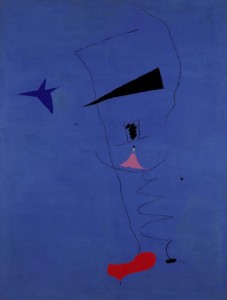
On the heels of a successful Art Basel show in Switzerland in June, Europe’s largest auction houses have started their own summer selling seasons with some strong results. One of the highlights of Sotheby’s Impressionist & Modern Art Sale in London on June 19, 2012, was a worldwide record set for Joan Miró’s Peinture (Étoile Bleue), c.1927. The painting sold for £23.5 million, well over pre-sale estimates of £15-20 million and three times its price when it last sold at auction in 2007.
Other works by Miró that fared well at the auction included a later gouache, Tête, that sold for over £260,000, exceeding its estimates of £150-200,000. There were also a handful of Salvador Dalí and Pablo Picasso works that sold above original estimates at the same sale. According to Artdaily.org, Sotheby’s worldwide totals for Impressionist and Modern Art this year currently sits at £435 million, an increase of more than 12 percent compared with the same period last year.
There may be several explanations for the increased demand in works by artists such as Miró. Peinture (Étoile Bleue) was considered by the artist to be a key work in his oeuvre. By the 1920s, the Catalan had begun to move from strictly representational work to explore the subjects of imagination and dreams, thus works such as this mark a stylistic change from his early career. Other artworks from this period are represented in both private and public collections around the world, marking this sale as a rare opportunity to acquire a painting from this period of Miró’s career.
The argument for the increasing demand for Spanish artists could also be due to recent large-scale retrospective exhibitions. This recent sale comes during the last leg of Joan Miró: The Ladder of Escape organized by the Fundació Joan Miró and Tate Modern (now showing in Washington D.C. with previous stops in London and Barcelona). An exhibition of works by Pablo Picasso called Picasso: Masterpieces from the Musée National Picasso, Paris is also on its last stop in Toronto after several other cities.
Strong art sales could also point to the nervousness of investors who are now willing to choose more tangible assets and liquidity as hedges against inflation and volatile stock markets. A recent report from Reuters notes the increase in demand for Swiss-based safety deposit boxes, suggesting more investors are filling them with objects and cash. An intriguing question arises when a patron tied to a major art institution expresses a similar need for liquidity.
Christie’s held its Old Master & British Paintings Sale in London on July 3, 2012. The highlight of this auction was the sale of a well-known landscape: John Constable’s The Lock, painted in 1824, one of six images of the Stour Valley, Suffolk, for £22.44 million — a worldwide record for a work by the painter.
The painting formed part of Baroness Carmen Thyssen Bornemisza’s private art collection that was housed in Madrid’s Museo Thyssen Bornemisza. It had been purchased in 1990 by the Baroness’s late husband, a Swiss industrialist and art collector who had resided in Spain for a number of years. According to BBC reports, the choice to sell the work was made due to a lack of liquidity. It has not occurred without controversy and criticism however, with Sir Norman Rosenthal (a former Royal Academy exhibitions director) resigning as museum trustee in protest at the sale.
Whether this sale is a bellwether for artworks that remain in private hands in Iberia or merely an isolated occurrence remains to be seen. What is certain is that despite the economic climate this season’s art auction sales will continue to yield strong results and this may be one of the most successful and controversial years in the industry for some time.
Leave a Reply
You must be logged in to post a comment.